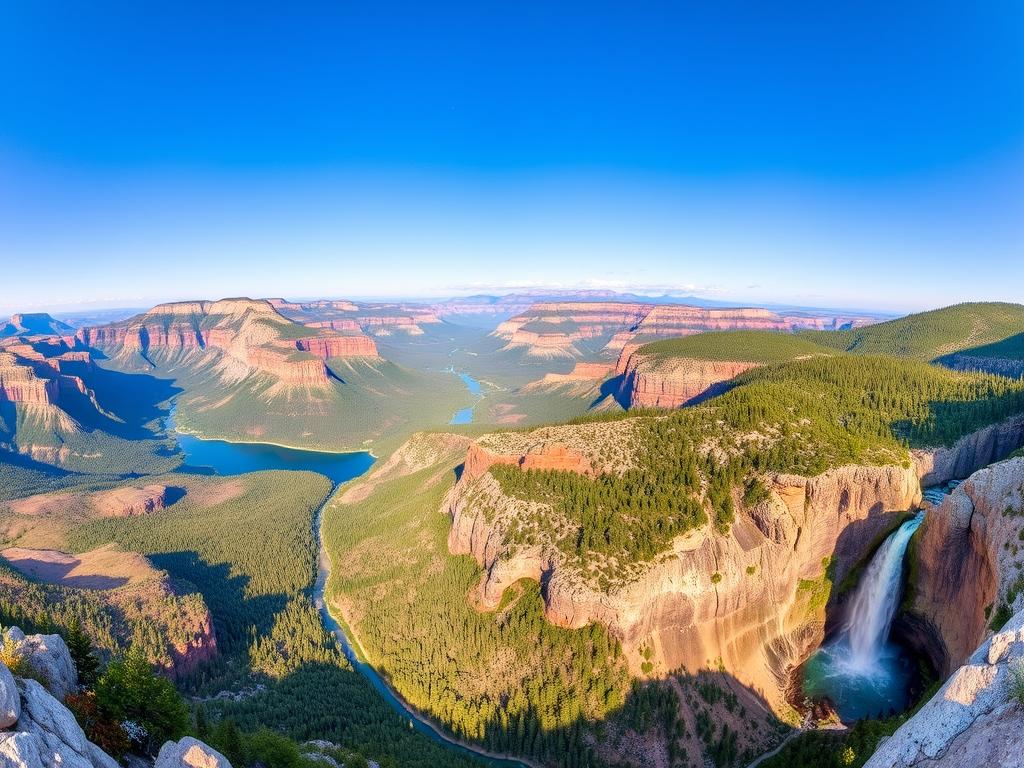Imagine standing on the edge of a canyon, watching the sun cast brilliant hues of orange and pink across the rocks as it sets.
The air feels alive with the sound of rustling leaves and distant bird calls, whispering stories of the earth’s beauty that stretches as far as the eye can see. This intimate connection with nature is what makes visiting national parks a transformative experience—one that resonates deeply within our souls.
Each year, millions of visitors venture into the best national parks, eager to immerse themselves in the breathtaking landscapes and pristine beauty that these unique havens offer.
From the geothermal wonders of Yellowstone to the coastal charm of Acadia, this guide explores the Top 15 National Parks to Visit for Unforgettable Scenery, inviting you to discover and celebrate the diverse ecosystems and stunning vistas that make these national treasures so remarkable.
4o
Key Takeaways
- Each national park showcases unique landscapes and ecosystems.
- Great Smoky Mountains National Park is the most visited park in the USA, attracting over 13 million visitors.
- Explore must-see destinations like Yellowstone, Acadia, and the Grand Canyon.
- National parks provide endless opportunities for hiking, wildlife spotting, and photography.
- Visiting national parks fosters a deeper appreciation of nature and conservation.
1. Yellowstone National Park: Nature’s Grand Showcase
Yellowstone National Park, established in 1872, proudly stands as the first national park in the world. This vast wilderness spans over 2.2 million acres, making it one of the largest national parks with stunning views. Travelers flock here to marvel at its remarkable geothermal features and diverse ecosystems.
1.1 Unique Geological Features
The park is renowned for its unique geological features, including more than half of the world’s geysers. These geothermal wonders, such as the iconic Old Faithful and the vibrant Grand Prismatic Spring, captivate millions of visitors. From colorful hot springs to bubbling mud pots, every corner of Yellowstone reveals nature’s artistry. The park also contains numerous lakes and canyons, providing a picturesque backdrop for your adventure.
1.2 Wildlife Spotting Opportunities
Yellowstone serves as a paradise for wildlife spotting enthusiasts. Visitors can encounter a variety of species, including bison, elk, wolves, and grizzly bears. Exciting opportunities abound, from guided wildlife tours that last up to 12 hours to 6-hour hikes along the Grand Canyon of Yellowstone. Each excursion delivers breathtaking views alongside the chance to witness these magnificent creatures in their natural habitat.

| Tour Type | Duration | Starting Price |
|---|---|---|
| Day Tours (BrushBuck Wildlife Tours) | 12 hours | $329 |
| Small-Group Tour (Teton Floats) | 11 hours | $299 |
| Snowmobile Tour (Scenic Safaris) | 12 hours | $525 (single), $855 (tandem) |
| Rafting Trip (Flying Pig Adventures) | 2 hours | $74 (adults), $64 (kids) |
| Kayak Tour (Geyser Kayak Tours) | 5 hours | $200 (single), $175 (tandem) |
| Hiking Guides (Yellowstone Hiking Guides) | 6 hours | $182 |
| Snowcoach Tour to Old Faithful | 9 hours | $230 (adults), $210 (kids) |
2. Grand Canyon National Park: Awe-Inspiring Landscapes
Grand Canyon National Park stands as a testament to nature’s artistry, offering visitors a remarkable showcase of awe-inspiring landscapes. The formations and vistas found here are more than just visually stunning; they reveal Earth’s geological history over billions of years. With its unique rock layers and dramatic depths, this park captures the imagination of all who visit, making it a must-see destination.
2.1 Best Viewing Points
The park features a variety of best viewing points, each providing a unique perspective on the canyon’s grandeur. Key highlights include:
- Mather Point: Offers expansive vistas of the canyon, easily accessible from the South Rim.
- Yavapai Observation Station: Features an informative geological exhibit alongside stunning views.
- Desert View Drive: A scenic route that allows stops at multiple overlooks, including the iconic Watchtower.
Visitors flock to these spots to capture unforgettable photographs and immerse themselves in the breathtaking scenery that defines the Grand Canyon National Park.
2.2 Hiking Trails and Experiences
For those seeking adventure, the park offers exceptional hiking experiences. Trails vary in difficulty and length, catering to all levels of outdoor enthusiasts. Notable trails include:
- Bright Angel Trail: A popular choice, this trail leads down into the canyon, providing a close-up view of its geological features.
- South Kaibab Trail: Renowned for its panoramic views, this trail offers a race against the sun to witness spectacular sunrises and sunsets.
Exploring the less frequented North Rim or aiming for the Colorado River adds an exciting twist to any excursion. Each hike reveals the park’s diverse ecosystems and a chance to reconnect with nature’s beauty.
3. Yosemite National Park: A Granite Paradise
Yosemite National Park stands out as a true granite paradise, renowned for its breathtaking landscapes and iconic landmarks. From towering cliffs to mesmerizing waterfalls, this park attracts visitors year-round, offering a plethora of seasonal attractions that cater to all kinds of outdoor enthusiasts.
Iconic Landmarks
Among Yosemite’s legendary features, El Capitan and Half Dome reign supreme. These granite giants not only showcase the park’s natural beauty but also serve as challenges for climbers from around the globe. Yosemite Falls, one of the tallest waterfalls in North America, captivates photographers and hikers alike, particularly during the spring when the meltwater cascades down with full force.
Seasonal Attractions
The best time to visit Yosemite National Park is between May and September. During this period, vibrant wildflowers adorn the meadows, and trails come alive with hikers eager to experience the stunning scenery. Each season offers its own unique charm; winter blankets the park in snow, providing excellent conditions for cross-country skiing and snowshoeing. Whether surrounded by spring blooms or winter wonderland, visitors find ample opportunities to appreciate nature’s artistry in this magnificent granite paradise.

4. Zion National Park: Red Rock Wonders
Zion National Park stands out as one of the top choices for adventurers and nature lovers seeking stunning landscapes. Renowned for its vibrant red rock wonders and towering sandstone cliffs, the park offers visitors a unique experience. The natural beauty of Zion is complemented by a diverse range of activities designed to cater to all levels of adventurers.
Top Hiking Trails
The park boasts numerous hiking trails that attract people from all over the globe. Among the most popular paths are:
- Angels Landing: This challenging hike provides breathtaking panoramic views from the summit.
- The Narrows: A unique hike through the Virgin River, offering a refreshing challenge under towering canyon walls.
- Observation Point: Less crowded yet equally stunning, this trail delivers breathtaking views without the extreme difficulty of Angels Landing.
Each of these top hiking trails showcases the dramatic geological features that define Zion National Park. Visitors will appreciate the area’s rich ecosystems and vibrant wildlife along their journeys. For more detailed information on various trails, refer to this guide.
Scenic Drives and Photography Tips
For those who prefer a relaxed approach, Zion offers several scenic drives that provide stunning views without strenuous effort. The Zion Canyon Scenic Drive stands as a highlight, allowing access to many of the park’s spectacular viewpoints. Photographers should aim for early morning or late afternoon visits to capture the warm glow of the red rocks against the crisp blue sky.

Ideal times to photograph Zion National Park occur during spring and fall, specifically from April to May or September to November. During these months, the weather is pleasant and the colors of the landscape are at their most vibrant. Whether trekking on the top hiking trails or cruising along the scenic drives, Zion remains an unparalleled destination for those captivated by nature’s beauty.
5. Glacier National Park: An Alpine Adventure
Glacier National Park is a jewel of the American wilderness, covering over a million acres of pristine natural beauty. Visitors come to experience the enchanting landscapes filled with majestic glaciers and vibrant ecosystems. Whether you are seeking a thrilling alpine adventure or a peaceful retreat, this park has something for everyone.
5.1 Majestic Glaciers and Lakes
More than 26 glaciers stand as remnants of the last Ice Age, with their beauty being a significant draw for tourists. These majestic glaciers are slowly retreating due to climate change, making visits even more poignant. Popular spots such as Lake McDonald and St. Mary Lake offer breathtaking views and opportunities for exploration. The Going-to-the-Sun Road spans 50 miles through the park, crossing the Continental Divide at Logan Pass, which reaches an elevation of 6,646 feet. This iconic drive is ideal for photography and provides stunning vistas of both glaciers and lakes.
5.2 Wildlife and Ecosystems Overview
Glacier National Park is a vital preserve for numerous wildlife ecosystems, housing species like grizzly bears, mountain goats, and moose. The park’s diverse terrains, featuring mountains and valleys, support a wide variety of life, offering many opportunities for wildlife viewing. Visitors can encounter these animals while hiking on over 700 miles of trails tailored to various skill levels. Trails such as the Grinnell Glacier Trail and the Avalanche Lake Trail give guests a chance to explore unique environments and observe how life adapts within them.
| Feature | Details |
|---|---|
| Total Area | Over 1 million acres |
| Number of Glaciers | 26 |
| Hiking Trails | 700 miles |
| Entrance Fee | $35 per vehicle |
| Popular Lakes | Lake McDonald, St. Mary Lake |
| Best Visiting Season | May to September |
| Wildlife Highlights | Grizzly bears, mountain goats, moose |
| Shuttle System | Available during peak season |
6. Acadia National Park: Coastal Beauty
Acadia National Park, located in Maine, encompasses approximately 49,075 acres of stunning coastal beauty, featuring a unique blend of rugged granite cliffs and picturesque shorelines. Renowned for its breathtaking landscapes, the park invites you to explore its extensive network of hiking trails, with popular trails like the Cadillac Summit Loop offering rewarding views atop the highest point on the east coast. The Precipice Trail also provides an exhilarating adventure for adventurous hikers, captivating visitors with its remarkable vistas.
6.1 Popular Trails
The park boasts over 120 miles of hiking trails, making it an outdoor enthusiast’s paradise. Cadillac Mountain and the Precipice Trail are just a few examples of popular trails that allow hikers to immerse themselves in the beauty of Acadia’s unique flora and fauna. This diversity includes enchanting wildflowers and fascinating wildlife, such as seals and peregrine falcons, showcasing the rich ecosystem of the region.
6.2 Unique Flora and Fauna
Acadia is renowned for its diverse natural habitats. The park’s unique flora and fauna play a significant role in maintaining the area’s stunning biodiversity. Visitors can expect to encounter a wide range of wildlife, transforming each hiking experience into a remarkable adventure filled with memorable encounters.
6.3 Best Times to Visit
For those planning a visit, the best times to explore Acadia National Park are in the summer and fall, particularly from September to early October, and May to June. During these seasons, the trails are fully accessible, and the vibrant fall foliage paints the landscape in breathtaking colors, captivating all who venture into this natural paradise. Plan your trip and discover why Acadia National Park is considered a must-visit destination in the heart of nature’s embrace. Learn more about the captivating experiences offered in Canadian parks here.











